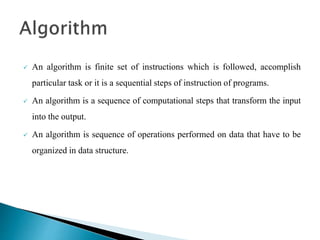Algorithm analysis in fundamentals of data structure
- 2. An algorithm is finite set of instructions which is followed, accomplish particular task or it is a sequential steps of instruction of programs. An algorithm is a sequence of computational steps that transform the input into the output. An algorithm is sequence of operations performed on data that have to be organized in data structure.
- 3. Every algorithm must satisfy the following criteria- 1. Input- There are zero or more quantities which are externally supplied. 2. Output – At least one quantity is produced. 3. Definiteness – Each instruction must be clear and easy to understand. 4. Finiteness- Algorithm will terminate after finite number of steps. 5. Effectiveness- Every instruction must be roughly work out using pencil and paper. More effectively generated.
- 4. This is the technique to measure the performance of algorithm. It provides user friendliness, security, maintainability and usage space that determines the quality of algorithm. Efficiency of algorithm can be analysis at two different stages before implementation and after implementation. Algorithm analysis deals with execution running time of various operations are involved. The running time of an operations can be defined as number of computer instructions executed per operations.
- 5. 1. Priori analysis- This is the theoretical analysis of algorithm before implementation. Efficiency of algorithm measured by speed, constant have no effects on implementation. 2. Posterior analysis- The selected algorithm implemented using programming language. This is executed on target computer machine. In this analysis actual statistics like running time and space calculated after implementation.
- 6. Algorithms help us to understand scalability. Performance often draws the line between what is feasible and what is impossible. Algorithmic mathematics provides a language for talking about program behavior. The lessons of program performance generalize to other computing resources. Modularity, Correctness, Maintainability, Correctness, Robustness, User friendliness, Programming time, Simplicity, Reliability etc. Its important for good performance.
- 7. 1. Time complexity- This is a function describing the amount of time an algorithm takes in terms of amount of input to the algorithm. Time can means no. of comparisons between data types, inner loops are executed. Time also can be calculated which language, hardware, program or compiler is used. Time complexity = Compile time + Run or Execution Time.
- 8. 2. Space Complexity- Space complexity of an algorithm represents amount of memory space required by the algorithm in its life cycle. Two types of spaces are required- Fixed part- It required to store certain data and variables that are independent size of problem. For e.g. Constants, Program size etc. Variable part- It required by variables whose size depends on size of problem. For e.g. Dynamic memory allocation.
- 9. Algorithm: SUM(A,B) Step 1 - START Step 2 - C <- A+B+10 Step 3 – Stop 1 Space complexity S(P) of any algorithm P is S(P) = C+SP(I). Where, C is fixed part and S(I) is variable part of algorithm. There are three variables A,B,C and Constant. Space depends on data types of given variables and constant types of data.
- 10. Asymptotic analysis of an algorithm refers to define the mathematical foundation of its run time performance. For this purpose we used Best, Average and Worst cases. Asymptotic Notations- 1. Big O Notation, O – The notation O(n) is the way to express the upper bound of an algorithm running time. Its measure the worst case time complexity or longest amount of time an algorithm can possibly take to complete. f(n) (- O(g(n))
- 11. 2. Omega Notation, Ω – The notation Ω(n) is the way to express lower bound of an algorithm running time. It measure the best case time or minimum amount of time an algorithm can possible take to complete. f(n) (- Ω(g(n)) 3. Theta Notation, θ – The notation θ(n) is the formal way to express both the lower bound and upper bound of an algorithm running time can possible take to complete. f(n) (- θ(g(n))
- 13. 1. Best case analysis- Best case is that input to the algorithm which takes minimum time for execution of it. Example - Binary Search algorithm 1 2 3 4 5 6 7 8 9 Best case to search element at first position. It required O(1) time.
- 14. 2. Average case analysis- For average case analysis all possible sequence of size ‘n’ are input to the algorithm and average asymptotic time of algorithm is computed. Example - Binary Search algorithm 1 2 3 4 5 6 7 8 9 All elements of sorted array of size ‘n’ are searched one by one and total number of comparisons are computed. Average computation time = Total time/2. It requires O(log n) time.
- 15. 3. Worst case analysis- Worst case is that input to the algorithm which takes maximum time for execution of it. Example - Binary Search algorithm 1 2 3 4 5 6 7 8 9 Worst case search the last element of the list in O(n) time is required. If the element is absent then O(log n) time is required.
- 16. Input 1 ms 2 ms 3 ms 4 ms 5 ms A B C D E F G worst-case best-case }average-case?
- 17. 1. O(1) – Constant eg. Doing a null check 2. O(n) – Logarithmic eg. Searching sorted data 3. O(n) – Linear eg. Adding values in data set 4. O(n log n) – Linearithmic eg. Quick sort 5. O(n2) – Quadratic eg. Two nested loops 6. O(n^k) – Polynomial eg. Calculations of polynomials 7. O(2n) – Exponential eg. Brute force attacking a password 8. O(n!) – Factorial eg. Calculate Fibonacci series
- 19. The key take away here is that if you are working with large datasets you need to be careful when selecting proper data structure, algorithms you use.



















